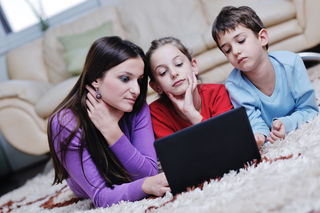Internet Addiction
Is Too Much Screen Time Bad?
How to create a screen time plan for your family
Posted April 20, 2019

We live in a digital world. Smartphones, iPads, tablets, computers—it seems as though everyone is plugged in and connected. Nowhere is this more evident than with our children. iGen, the generation born between 1996 and 2012, is particularly impacted, with nearly half of adolescents reporting being on their smartphones and other devices “constantly”1, and the average screen time use to be around 5 hours a day4. The youngest generation, Generation Alpha, isn’t immune to all of this technology usage. In a recent survey conducted by Hotwire and Wired Consulting, parents indicate that their children’s opinions heavily influence technology decisions in the home, including purchase decisions. Parents also report that technology is more important to their young children than toys, holidays or vacations7.
What does all of this mean? While researchers are only just learning of the true impact of screen time on cognitive and emotional processes, the early findings are not great. As little as two hours a day of screen time has been demonstrated to negatively impact the brain, with reductions in grey matter and changes to white matter3. Most researchers acknowledge the dopaminergic impact of screen time—screen time use leads to the release of dopamine similar to the way drugs like cocaine impact the brain. This has led to alarm regarding the long-term impact of increased screen time use (including time on phones, tablets, video games, and TV). These changes in the brain can result in reduced attention, memory difficulties and changes in our ability to think, read, and write at a deep level.
Changes to our brain functioning are not the only area of concern. Twenge and other researchers site profound decreases in happiness, increases in anxiety and depression and increased suicidal ideations and attempts in our youth6. Our children are struggling with social-emotional development impacting their resilience overall2.
Not all researchers agree with the arguments against technology and screen time. The Hotwire report pointed to some positive research as well. Video game use has been linked to some increases in hand-eye coordination and visual processing skills7. Furthermore, research has not been able to indicate causal relationships between screen time use and the adverse social-emotional outcomes, only correlations5.
What does this mean for parents? Regardless of whether screen time causes negative changes in the brain and increases in anxiety and depression, it’s clear to me that too much screen time does have negative impacts. This throws parents into a hard position. After all, we live in a digital world. If the experts at Hotwire and Wired Consulting are correct, our tech use is expected to increase over the next twenty years. We must learn to balance our screen time with human interaction to ensure the healthy development of our social-emotional intelligence. More importantly, we need to teach our children balance.
What does balance actually mean? Should we eliminate as much screen time use as possible, just to be “safe?” While some of you may answer yes, I think that is unrealistic and impractical. A more common sense approach is in order.
Start by establishing household expectations around screen time—when it is appropriate and not appropriate to engage in screen time. The following tips can help you create a screen time plan for your family:
- Set boundaries around screen time. Typical times to avoid screen use include meal times, bedtimes and while driving or engaging in activities when high levels of sustained attention are needed (homework time, etc.). If a screen is required for homework time or similar activities, teach children to set controls that limit texting and social media access while engaged in high-attention activities.
- Discuss the research about high screen time use with your children. Teach them how to determine if they engage with their screens too often. Take a balanced approach to the conversation, while still communicating clear expectations.
- Whenever possible, engage in screen-related activities with your child. Discuss the movie with your children, or ask questions about the game he or she plays.
- When determining how much screen time to allow, consider the following:
- What is the media used with the screen time (i.e., streaming a movie on a tablet, playing Minecraft versus Fortnite, listening to a book through audible on a smartphone)?
- Does the screen time use increase the value of the media?
- Does the activity require the use of a screen, or is it merely a convenience?
- Does the screen time use empower my child or enable my child?
- Is the activity passive (watching a screen) or active (involves in-person social contact with another or uses the technology in different ways, like making a video or taking pictures as opposed to watching a video)?
- Have explicit discussions around internet safety and cyber-bullying.
- Agree to take digital breaks as a family. This time “off the grid” may be difficult at first. Start with a day, or even a few hours. Use the time to increase in-person, social connection time as a family.
- Practice digital restraint and balance yourself. After interviewing hundreds of children for the parenting books that I’ve written, one thing is clear to me—children want us to reduce our screen time and increase connections with them as much as we wish this of them.
- What is the media used with the screen time (i.e., streaming a movie on a tablet, playing Minecraft versus Fortnite, listening to a book through audible on a smartphone)?
- Does the screen time use increase the value of the media?
- Does the activity require the use of a screen, or is it merely a convenience?
- Does the screen time use empower my child or enable my child?
- Is the activity passive (watching a screen) or active (involves in-person social contact with another or uses the technology in different ways, like making a video or taking pictures as opposed to watching a video)?
Living in this new, digital world can be confusing. Screen time management can feel daunting. But technology in and of itself is not the enemy. It can improve our world. The key is treating it as a tool to enhance our development as humans, not something to which we abdicate control. Take back the reins and develop a balanced approach to screen time with your family. Your children are relying on you.
References
1. Anderson, M., & Jiang, J. (2018). Teens, social media & technology 2018. Pew Research Center. Retrieved from https://www.pewinternet.org/2018/05/31/teens-social-media-technology-20…
2, Fonseca, C. (2019). The Caring Child: Raising Empathetic, Emotionally Intelligent Children. Waco,TX: Prufrock Press.
3. Stafford, C. (2018). Stress, sleep, cell-phones, and smarts: The Neuroscience behind teenage motivation and performance. ASCA Annual Conference: Reach for the Stars. Los Angeles.
4. Twenge, J. M. (2017). iGen: Why Today's Super-Connected Kids Are Growing Up Less Rebellious, More Tolerant, Less Happy - and Completely Unprepared for Adulthood. New York, NY: Atria Books.
5. Twenge, J. M. (2019). The sad state of happiness in the United States and the role of digital media (World Happiness Report). Retrieved from https://worldhappiness.report/ed/2019/the-sad-state-of-happiness-in-the….
6. Twenge, J. M., & Campbell, W. K. (2018). Associations between screen time and lower psychological well-being among children and adolescents: Evidence from a population-based study. Preventive Medicine Reports, 12, 271-283. doi:10.1016/j.pmedr.2018.10.003.
7. Understanding Generation Alpha. (2018). Retrieved from https://www.hotwireglobal.com/feature/understanding-generation-alpha-2


